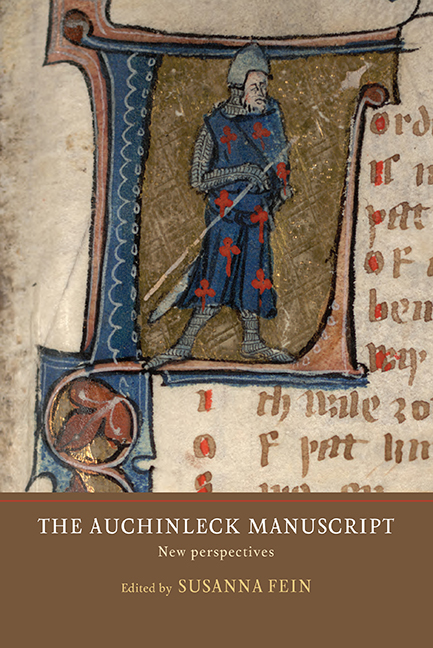Book contents
- Frontmatter
- Contents
- List of Illustrations
- List of Contributors
- Acknowledgements
- Abbreviations
- Note on the Presentation of Auchinleck Texts
- Introduction The Auchinleck Manuscript: New Perspectives
- 1 The Auchinleck Manuscript Forty Years On
- 2 Codicology and Translation in the Early Sections of the Auchinleck Manuscript
- 3 The Auchinleck Adam and Eve: An Exemplary Family Story
- 4 A Failure to Communicate: Multilingualism in the Prologue to Of Arthour and of Merlin
- 5 Scribe 3’s Literary Project: Pedagogies of Reading in Auchinleck’s Booklet 3
- 6 Absent Presence: Auchinleck and Kyng Alisaunder
- 7 Sir Tristrem, a Few Fragments, and the Northern Identity of the Auchinleck Manuscript
- 8 The Invention of King Richard
- 9 Auchinleck and Chaucer
- 10 Endings in the Auchinleck Manuscript
- 11 Paraphs, Piecework, and Presentation: The Production Methods of Auchinleck Revisited
- 12 Scribal Corrections in the Auchinleck Manuscript
- 13 Auchinleck ‘Scribe 6’ and Some Corollary Issues
- Bibliography
- Index of Manuscripts Cited
- General Index
- Manuscript Culture in the British Isles
1 - The Auchinleck Manuscript Forty Years On
Published online by Cambridge University Press: 21 May 2021
- Frontmatter
- Contents
- List of Illustrations
- List of Contributors
- Acknowledgements
- Abbreviations
- Note on the Presentation of Auchinleck Texts
- Introduction The Auchinleck Manuscript: New Perspectives
- 1 The Auchinleck Manuscript Forty Years On
- 2 Codicology and Translation in the Early Sections of the Auchinleck Manuscript
- 3 The Auchinleck Adam and Eve: An Exemplary Family Story
- 4 A Failure to Communicate: Multilingualism in the Prologue to Of Arthour and of Merlin
- 5 Scribe 3’s Literary Project: Pedagogies of Reading in Auchinleck’s Booklet 3
- 6 Absent Presence: Auchinleck and Kyng Alisaunder
- 7 Sir Tristrem, a Few Fragments, and the Northern Identity of the Auchinleck Manuscript
- 8 The Invention of King Richard
- 9 Auchinleck and Chaucer
- 10 Endings in the Auchinleck Manuscript
- 11 Paraphs, Piecework, and Presentation: The Production Methods of Auchinleck Revisited
- 12 Scribal Corrections in the Auchinleck Manuscript
- 13 Auchinleck ‘Scribe 6’ and Some Corollary Issues
- Bibliography
- Index of Manuscripts Cited
- General Index
- Manuscript Culture in the British Isles
Summary
THE facsimile of the Auchinleck manuscript was published in 1977 on the break of a wave of published facsimiles of manuscripts of Middle English verse. There had been facsimiles published by the Early English Text Society of the Gawain manuscript and the Harley manuscript as ‘one-off’ ventures, a very old facsimile of the Ellesmere manuscript, and a recent one of the Lincoln Thornton manuscript. But Auchinleck was immediately followed by facsimiles of the Findern manuscript, CUL Ff. 2. 38, Fairfax 16, CUL Gg. 4. 27 and a stream of others, mostly published by either the Scolar Press or D. S. Brewer. The characteristic target was a miscellany or manuscript of varied contents such as would provide literary scholars with the kind of excitement that archaeologists take in a midden. The facsimile of the Hengwrt manuscript of the Canterbury Tales, which was published in 1979 by Pilgrim Books as part of the University of Oklahoma Variorum Chaucer project, itself followed by facsimiles of several manuscripts of Chaucer and Chaucer-related manuscripts from the same source, was part of the same production revolution, though with somewhat different literary objectives. The general outbreak of facsimile publication coincided with a vigorous and widespread new interest in the ‘material manuscript’, that is, the physical evidence in all its aspects – script, ornament, layout, binding, annotation, readers’ scribbles – of the medieval literary text. It only subsided when the functions that facsimiles had performed for medieval scholars and readers began to be taken over by digital forms of manuscript publication.
The introduction to the Auchinleck facsimile was written by myself and I. C. Cunningham, then Keeper of Manuscripts at the National Library of Scotland. Dr Cunningham's contribution, comprising a physical description of the manuscript, a detailed collation, and a description of script and ornament and of binding, has mostly stood the test of time. My own contribution to the introduction dealt with the literary and historical significance of the manuscript, including the organization of its production in the form of booklets, its origins in a London ‘bookshop’, its prospective audience, and its contents. Unfortunately, the ‘bookshop’ idea was soon overtaken by events.
- Type
- Chapter
- Information
- The Auchinleck Manuscript: New Perspectives , pp. 11 - 25Publisher: Boydell & BrewerPrint publication year: 2016
- 3
- Cited by

